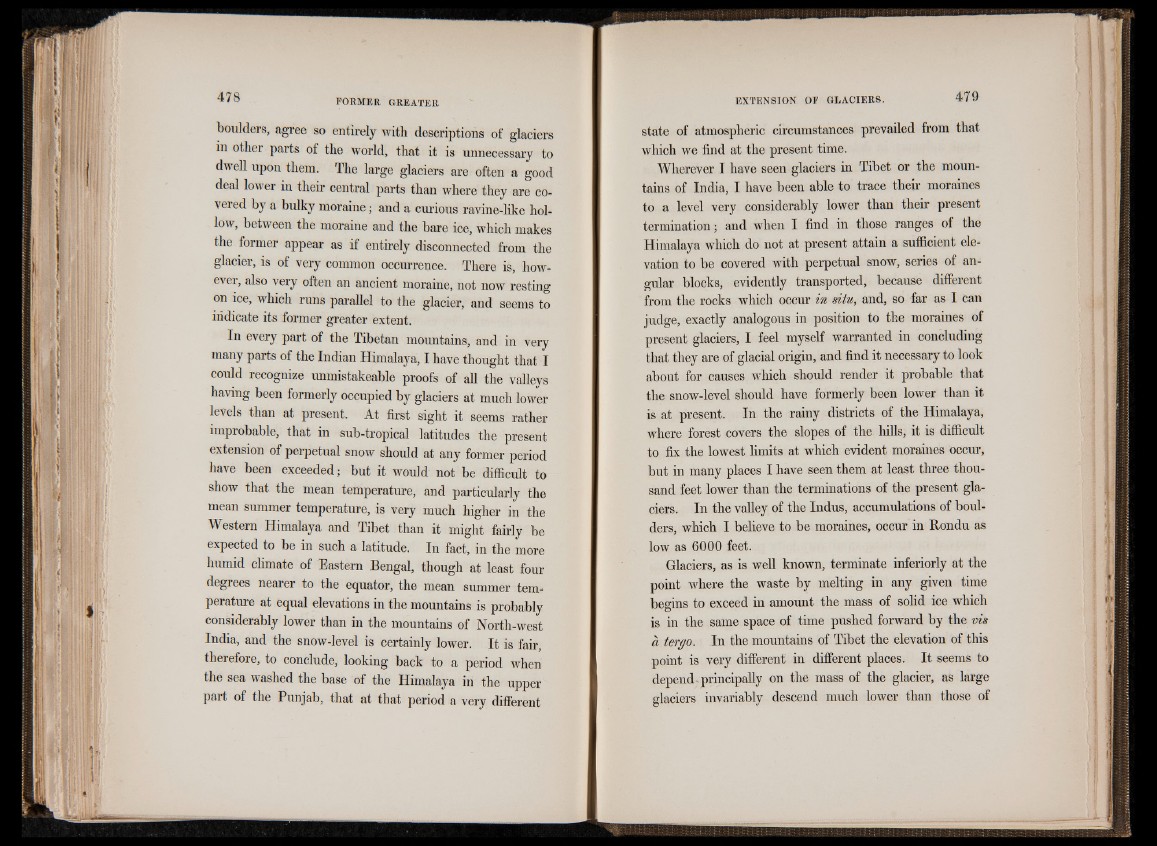
boulders, agree so entirely with descriptions of glaciers
in other parts of the world, that it is unnecessary to
dwell upon them. The large glaciers are often a good
deal lower in their central parts than where they are covered
by a bulky moraine; and a curious ravine-like hollow,
between the moraine and the bare ice, which makes
the former appear as if entirely disconnected from the
glacier, is of very common occurrence. There is, however,
also very often an ancient moraine, not now resting
on ice, which runs parallel to the glacier, and seems to
indicate its former greater extent.
In every part of the Tibetan mountains, and in very
many parts of the Indian Himalaya, I have thought that I
could recognize unmistakeable proofs of all the valleys
having been formerly occupied by glaciers at much lower
levels than at present. At first sight it seems rather
improbable, that in sub-tropical latitudes the present
extension of perpetual snow should at any former period
have been exceeded; but it would not be difficult to
show that the mean temperature, and particularly the
mean summer temperature, is very much higher in the
Western Himalaya and Tibet than it might fairly be
expected to be in such a latitude. In fact, in the more
humid climate of Eastern Bengal, though at least four
degrees nearer to the equator, the mean summer temperature
at equal elevations in the mountains is probably
considerably lower than in the mountains of North-west
India, and the snow-level is certainly lower. It is fair,
therefore, to conclude, looking back to a period when
the sea washed the base of the Himalaya in the upper
part of the Punjab, that at that period a very different
state of atmospheric circumstances prevailed from that
which we find at the present time.
Wherever I have seen glaciers in Tibet or the mountains
of India, I have been able to trace their moraines
to a level very considerably lower than their present
termination; and when I find in those ranges of the
Himalaya which do not at present attain a sufficient elevation
to be covered with perpetual snow, series of angular
blocks, evidently transported, because different
from the rocks which occur in situ, and, so far as I can
judge, exactly analogous in position to the moraines of
present glaciers, I feel myself warranted in concluding
that they are of glacial origin, and find it necessary to look
about for causes which should render it probable that
the snow-level should have formerly been lower than it
is at present. In the rainy districts of the Himalaya,
where forest covers the slopes of the hills, it is difficult
to fix the lowest limits at which evident moraines occur,
but in many places I have seen them at least three thousand
feet lower than the terminations of the present glaciers.
In the valley of the Indus, accumulations of boulders,
which I believe to be moraines, occur in Rondu as
low as 6000 feet.
Glaciers, as is well known, terminate inferiorly at the
point where the waste by melting in any given time
begins to exceed in amount the mass of solid ice which
is in the same space of time pushed forward by the vis
a ter go. In the mountains of Tibet the elevation of this
point is very different in different places. It seems to
depend principally on the mass of the glacier, as large
glaciers invariably descend much lower than those of